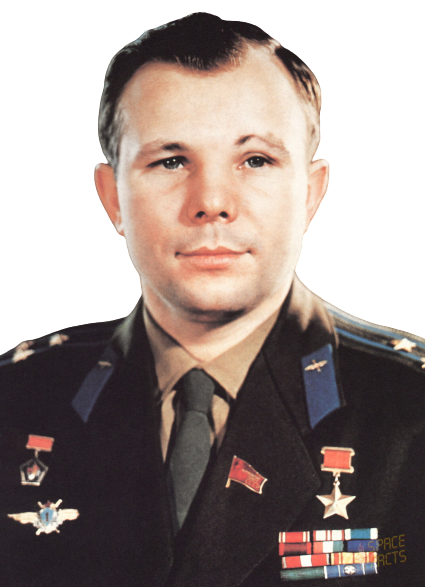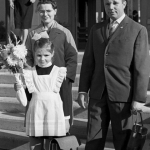
17.12.2022
In October 1963, Yuri Alekseyevich Gagarin and Valentina Vladimirovna Tereshkova, accompanied by Lieutenant General Nikolai Petrovich Kamanin, visited Mexico and stayed in New York on the way back, where they took part in the plenary session of the UN General Assembly.
It is noteworthy that while the Soviet press trumpeted the other trips continuously, it chose to report on this two-day visit very sparingly, and in later Soviet biographies it is not mentioned at all.
On October 16, the cosmonauts held a press conference where they were put to a serious test: unscrupulous American “pen-sharks” asked for specific information about the Soviet Union’s future plans for space exploration and future flights to the Moon. Their keen interest was understandable, for the United States had invested enormous sums in its Saturn-Apollo program, and the Americans were seriously concerned that billions of dollars might be wasted if the Soviet Union was once again ahead of them.
As was his habit, Yuri Gagarin answered questions evasively. I will cite here a few of his answers.
“Question: Lieutenant Colonel Gagarin, why is the USSR unwilling to cooperate with the United States in carrying out a joint project on the lunar program?
Answer: And what data do you have on this question?
Q: You said in Mexico City, sir, you were quoted as saying that the USSR was not willing to cooperate with the United States on this project.
Answer: There was no such statement by me.
Q: So the USSR is willing to cooperate with the United States in carrying out the moon landing?
Answer: This question was put forward by the president of the United States. But it was put forward in general terms. Of course, these issues need to be clarified. But that’s how I also heard, just like you did in Mexico, that the U.S. Congress banned these joint explorations.
Q: Is it true that there were reports that Lieutenant Colonel Gagarin would be the commander of the ship that would go to the moon? Is this true?
Answer: Actually, I can tell you in confidence that I really want to go to the Moon. Just like all our Soviet cosmonauts. Valentina Vladimirovna [Tereshkova] is also my competitor, she also wants to go to the Moon. Everyone wants to go up there, and it’s not yet clear which of us will go up there, but at least we all have this desire. And we really want our dream to come true.
Question: If the USSR is the first to send a spaceship to the Moon, will it make a legal claim to the Moon?
Answer: Well, there are legal issues here. We are astronauts, not lawyers. Our job is to fly, and it’s up to lawyers to set up laws, rights, and so on.
Question: Since Lieutenant Colonel Gagarin denies most of the statements attributed to him recently, can you comment on a statement attributed to you that the Soviet Union could go to the moon next year?
Answer: I did not make such a statement, at least not next year. That there will be such flights in the coming decade, that’s what I said.
Q: After the English astronomer Lovell returned from the Soviet Union, he made a statement that, in fact, the United States was in a race for the moon with itself and that the USSR had essentially withdrawn from that race. Is this true?
Answer: You see, I wouldn’t want to change Mr. Lovell’s mind on that point. But still the Moon is of some interest to humanity.
Q: That’s not really an answer to the question. I asked – is it true that the Soviet Union is refusing?
Answer: You know, all these projects are handled by the Academy of Sciences. I am not an academician, I am not on any board – so it is better to ask them.
Yuri Alekseevich once again demonstrated the ability to speak in public in such a streamlined way that no one could interpret his words in their own way. But by and large he had nothing to say to the Americans. The problem here is not in the twisted logic of propaganda, but primarily in the fact that the Soviet Union really did not have a coherent exploration program for the Moon for a long time.
Let’s make another little excursion into history to understand what the difficulties were. To reach the Moon, at least two things are needed: a spacecraft capable of reaching second space speed, and a powerful launch vehicle that could take such a spacecraft into a “support” orbit. The payload of the rocket determines the configuration of the spacecraft and the flight pattern. On the basis of the R-7 intercontinental rocket, it was possible to create an accelerated version of the launcher, which would pull a spacecraft with a mass of up to 6.5 tons into orbit. Such a craft was clearly insufficient for a normal expedition to the Moon. Therefore, in the late 1950s, the question arose about the creation of a super-heavy rocket N-1 (Carrier-1, or Science-1), which could carry up to 100 tons of payload into space. The existence of such a carrier would have made flights to the Moon and, in the future, to Mars possible. Of course, Sergei Pavlovich Korolev did not dare to design a super-heavy rocket right away, and in 1959 proposals were put forward to first build a lighter version – with a payload up to 40 tons. In June 1960, the CPSU Central Committee discussed proposals on promising missile, which the chief designer promised to make by 1963, and asked for three billion rubles for its development. However, the Ministry of Defense, to which all bureaus and institutes working on astronautics were more or less subordinated, was in no hurry to shower Korolev with money, but demanded a clear explanation why flights to other planets were needed to strengthen the defense capabilities of the country.
The course of further discussions on the issue was interrupted by the disaster at the Tyuratam test site, which killed Marshal Mitrofan Ivanovich Nedelin. The topic was returned to in January 1961, when it was arranged an “revision” meeting of the Soviet of Defense, which decided “to concentrate the efforts of the design organizations of industry in the first place to solve the most important problems in the interests of national defense”. Understandably, all top officials turned to this document when disputes arose. Sergei Korolev had to prove that his rocket H-1 could be used for military purposes: as a carrier for launching an orbital reconnaissance station and as a symmetric response to similar American rocket projects Saturn and Nova. However, the opponents of the H-1 also had their reasons: Defense Minister Rodion Malinovsky and the chief of General Staff Matvei Zakharov wrote in their notes to the CPSU Central Committee that the superpower missile cannot be used to strengthen the defense capability, because its production, testing and launch facilities are not concealed from enemy intelligence, hence they will become targets for a preemptive strike.
At the end of March, two weeks before Yuri Gagarin’s flight, the fate of the super-heavy rocket was decided: its development was postponed for two years. On April 7, the issue of closing funding for interplanetary spacecraft projects was put on the agenda. Sergei Korolev was able to defend only one project of his own, which could be implemented with a modified version of the existing R-7 rocket – a project to fly around the Moon in a small two-man craft without landing on its surface. However, they also told him to limit it to the conceptual design stage, postponing the submission deadline to 1963.
In other words, Yuri Gagarin did not even have time to go into space, and the political and military leadership of the country was already busy with the dismantling of their own space rocket program. In April 1961, of course, he did not know anything about it (after all, even the “Vostok” with the rocket he saw just recently), but by his press conference in New York in October 1963, he was well aware of the serious problems of Soviet manned space exploration. What could he tell the curious journalists? The truth? What kind of truth? After all, work on the lunar circumambulation project was underway, except that the actual shape of the future system was very far from complete.




